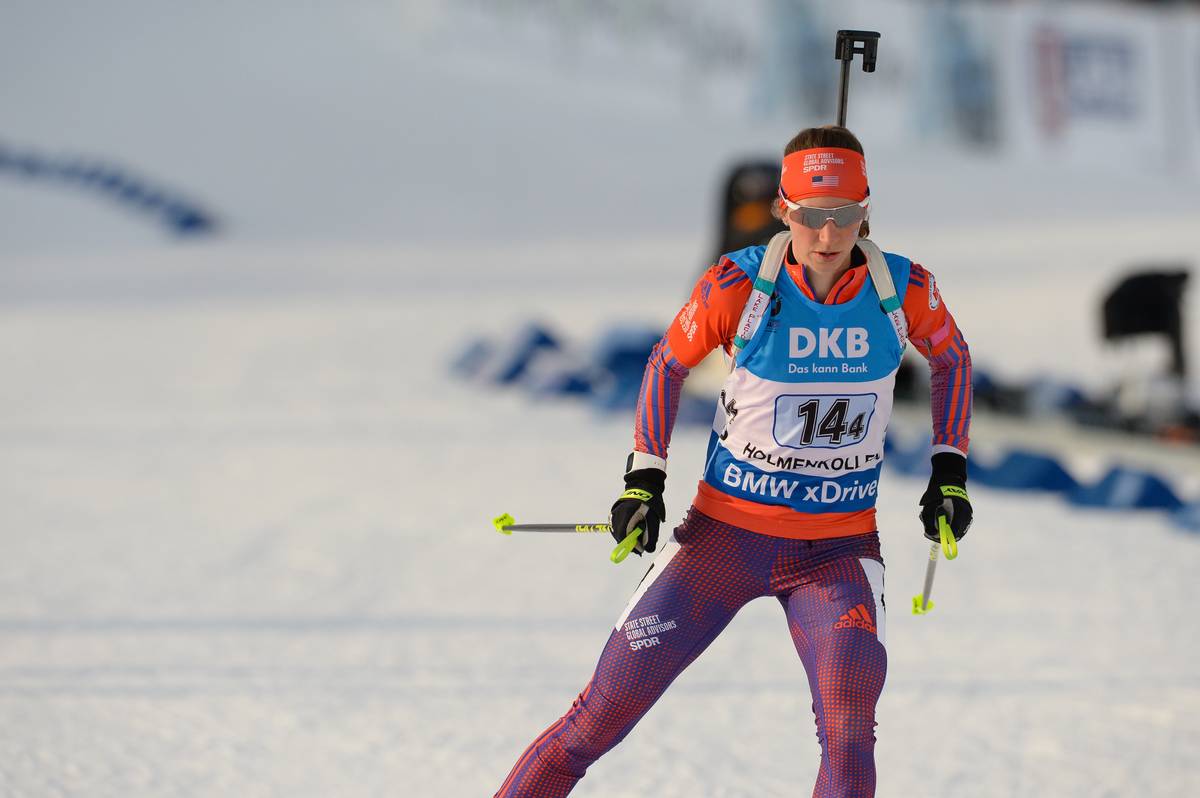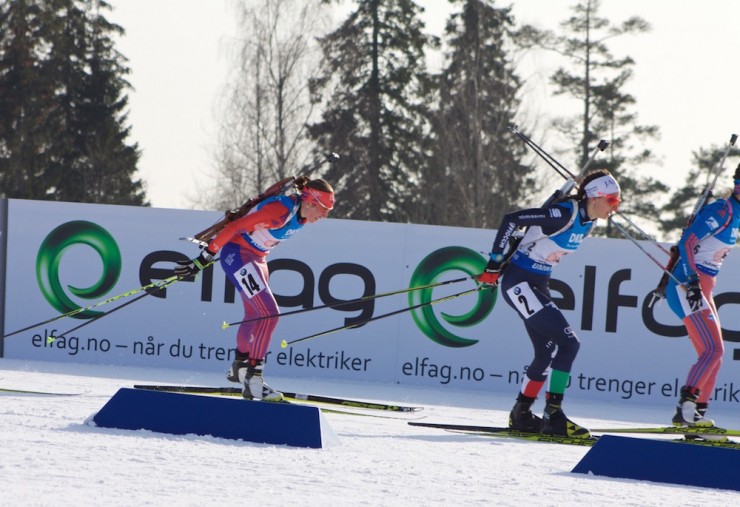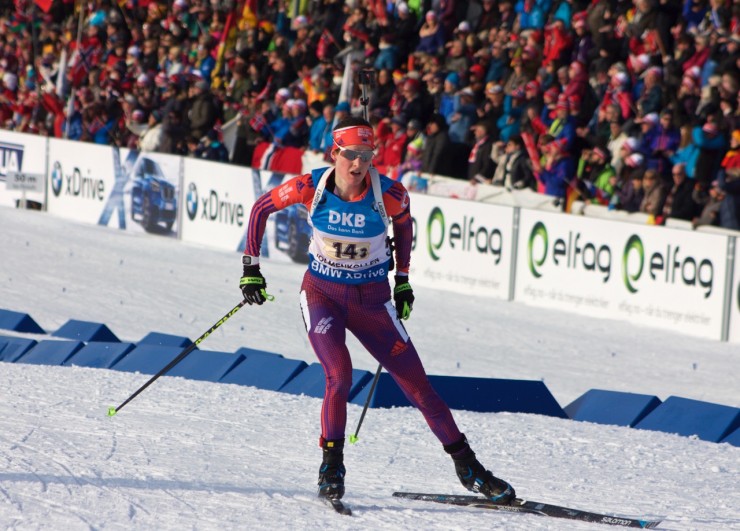
OSLO, Norway — The women’s 4 x 6-kilometer relay wasn’t just the last race of 2016 World Championships for part of the US Biathlon team, but also the last international race of some of their careers.
With both Hannah Dreissigacker and Annelies Cook set to retire – and neither are attending the final World Cups in Khanty-Mansiysk, Russia – it is the end of an era for the team.
“I’m really sad to be saying goodbye to Annelies and Hannah as teammates,” Clare Egan said. “Really, really sad. They are just great teammates, relay day or not relay day. Summertime, wintertime. We have big shoes to fill.”
But before they could laugh and cry and reminisce about so many training camps and racing trips done together, the women had to get through the relay, and they wanted a good result.
“I said last night in our race meeting, we definitely want to approach every day until the end of the World Championships very professionally,” U.S. women’s national team coach Jonne Kähkönen said. “Sure, there are a lot of emotions. You have to put those on the side, and finish the day first, and then celebrate the retirements. But have a good focus all the way through.”
“We want to have fun on this last day, and we want to put together a good result to have a good memory to go out on,” Susan Dunklee agreed. “When you’re seeking fun, that doesn’t mean that you don’t work hard and it doesn’t mean that you’re unprofessional or you’re not doing the focused work that you need to do. But I think that’s the common misconception when we talk about fun. Fun means keeping yourself motivated to be hungry and to want to do the work.”
Dunklee led things off for the United States, cleaning prone with no spare rounds and going out with the leaders.
“I don’t think I’ve ever seen so much contact in the women’s field in a mass start situation,” she said of the early going. “People were bumping elbows and poles, and stepping on each others’ skis, and I saw a couple different people go down. People were moving back and forth across the trail more than they usually do. It was really difficult to move up today.”

Dunklee tried to attack on the second loop, but was quickly caught.
“I don’t think I felt as sharp on skis,” she said, comparing the effort to her leadoff leg in the mixed relay a week ago, where she tagged off in first place.
“I didn’t have the gas to quite go as hard, and when I did go hard I didn’t recover. I think all this racing is starting to get to me a little bit. I attacked off the front, and then people passed me on that downhill leading into the big hill. They caught right back up, so I thought it was stupid to waste that much energy if I’m not going to make a big break.”
Dunklee then used two spare round in standing and tagged off in tenth place, 28.2 seconds back. Her ski time was the second-fastest of all leadoff skiers.
She tagged off to Dreissigacker, who was in the last relay race of her career. Things didn’t go perfectly, and the team fell to 16th.
“Shooting, I had to use three spares,” Dreissigacker explained. “I am not that happy with my shooting, but it still wasn’t terrible. It’s just a tough competition out there today. There are all kinds of teams at the top.”
Egan moved up to 14th with two spares, before tagging off to Cook.
Cook had only announced her retirement publicly in the last 24 hours, and of all the emotions running rampant on the team, hers were the strongest.
“I was so nervous, oh my god,” she said. “I wanted to be able to finish in a good way, with my team. I had the worst butterflies all day long. But I was just really happy to ski.”
And after being frustrated in the sprint, after a bout of pre-Championships illness, Cook felt her ski speed come back around as the week went on. She used just one spare round on the anchor leg and was left with a performance she could feel happy about. She crossed the line smiling in 13th place, 3:47.1 behind the winning Norwegian team.
“I think Annelies did a great job today,” Kähkönen said. “Cleaning quick in prone, and then just one reserve in standing. That was excellent execution. To her potential, I mean, that’s how Annelies Cook shoots.”
Still, even out on the course there were bits of emotion.
“On the last little bit I saw Hannah, and Susan and Clare, and they are such a great team,” Cook said, tears wellling up in her eyes. “I’m going to miss them so much. It has been a really amazing adventure with a lot of really good people.”
The result wasn’t the best of the season. The U.S. had finished tenth in the last World Cup relay before World Championships, at home in Presque Isle, Maine.

“We maybe just didn’t have the energy on the skis today,” Egan said. “It seemed like some of the other teams were performing extremely well. I don’t think we were performing poorly.”
Kähkönen thought that was a fair assessment.
“At the World Champs, that’s just the level [of competition],” he said. “You need that good shooting, and even better shooting, and the best shape of the day. And as usual, we had a few surprises mixed in there. Like the Slovenian team, and Kazakhstan definitely had a great day today.”
Now, the team is looking forward to Dunklee and Dreissigacker competing in Sunday’s mass start, the first time ever that two American woman qualified for the 30-woman event at a Championships.
From there, Dunklee and Egan will go to Khanty-Mansiysk to finish off the World Cup, while the retirees will go home, and then to North American Championships in Fort Kent, Maine.
After that, it’s time for the team to contemplate life with two fewer members.
“I’m going to miss them so much. It has been a really amazing adventure with a lot of really good people.” — Annelies Cook (US Biathlon) on retiring
“It will be a great challenge,” Kähkönen said. “We’ve talked about this for the last two years now. Ever since Sochi I guess. Just trying to find ways to bring in more resources and effort into development, because it’s a long path. I typically say it’s four, five, six years, depending on where you start from, to get to a true World Cup level. I mean, even Clare [Egan, who started biathlon three years ago], she is doing awesome, but still on the way. She is in the process of getting there.”
Dunklee and Egan both agreed that there is plenty of opportunity for their team, naming Maddie Phaneuf and Joanne Reid as women they are excited to work with more next season.
“We have some candidates,” Dunklee said. “It’s going to be a fun challenge, getting some new people up to speed. There’s hope. We have a bright future.”
Kähkönen sees Dunklee, who has had world class performances each of the last several seasons and turned in a top-ten sprint result earlier in World Championships, as the ‘captain’ of the team going forward.
But team cohesion and a supportive atmosphere are hallmarks of the U.S. women’s team, and he doesn’t see any problem fitting new candidates into that group.
“The others members took Joanne into the team immediately,” Kähkönen said of Reid’s first World Cup experience. “It was good to see. And I must say, it was almost out of the blue that she raced national trials, and then IBU Cup, and then most of the [World Cup] athletes had not seen her, had not even met her. So I think they did a good job, and at the same time that’s just how the team operates.”
Memories of the atmosphere that Cook and Dreissigacker helped create will inform the group moving forward.
“These awesome experiences you have with your teammates, these bonding moments whether it’s training in the mountains in the summer or in the pouring rain when nobody wants to be out but you’re out there and you’re badass, those keep you motivated,” Dunklee said. “Your teammates make it fun.”
— Harald Zimmer contributed reporting.
Chelsea Little
Chelsea Little is FasterSkier's Editor-At-Large. A former racer at Ford Sayre, Dartmouth College and the Craftsbury Green Racing Project, she is a PhD candidate in aquatic ecology in the @Altermatt_lab at Eawag, the Swiss Federal Institute of Aquatic Science and Technology in Zurich, Switzerland. You can follow her on twitter @ChelskiLittle.



